You have no items in your shopping cart.
Tang Dingling Mausoleum
Introducing Dingling Mausoleum of Tang Dynasty
Tang Dingling Mausoleum is located in Fuping County, 75 km (47 mi) north of Xi'an. Dingling Mausoleum of Tang Dynasty is where Emperor Zhongzong, the 4th emperor of the Tang Dynasty was buried. Emperor Zhongzong was born in 656. He became the emperor of the Tang dynasty after his father, Emperor Gaozong died in 683. Emperor Zhongzong held two reigns in the Tang dynasty. The first was for six weeks. His mother, Empress Wu Zetian, had him removed as emperor. Zhongzong went into seclusion for the next 14 years. His brother, Emperor Ruizong, and his mother, Empress Regnant Wu Zetian, ruled China. In 705 CE, Empress Wu Zetian was forced to abdicat the throne and Emperor Zhongzong resumed his rule over China. Emperor Zhongzong died in 710 at the age of 55 from possible poisoning by his wife and his daughter. His brother, Emperor Ruizong, succeeded him again as the emperor of the Tang dynasty. Emperor Zhongzong was buried in November, 710 at the 751 meter elevated Phoenix Mountain. It is recorded that Dingling Mausoleum was plundered in 908 by the local governor of Yaozhou during the period of Five Dynasties after the Tang Dynasty was overthrown in 907.
Watch this video showcasing Dingling Mausoleum of Tang Dynasty
Kind Notice: This video is not available in China (YouTube is blocked). If you are in China, click here.
Dingling Mausoleum of Tang Dynasty Fast Facts
• Chinese Name: Tang Ding Ling 唐定陵
• Best Time to Visit: All year round
• Recommended Visiting Hours: 2 hours
• Distance from Xian: 75 km (47 mi)
• Opening Hours: All day
• Entrance Fee: Free
• Address: Shiziwo Village, Gongli Township, Fuping County, Shaanxi Province
What to expect at Dingling Mausoleum of Tang Dynasty
Dingling Mausoleum was modeled after its previous Qianling Mausoleum which set standard for all the Tang dynasty imperial tombs that followed. The mausoleum layout resembles the city plan of the capital city of Chang'an. Three ceremonial gates were built to the south of the tomb mountain. The first ceremonial gate represents Mingde Gate, the south gate of Chang'an's outer city; the second ceremonial gate represents the Vermillion Bird Gate, the south gate of Chang'an's royal city where government offices were located; the third ceremonial gate resembles the Gate of Heavenly Succession, the south gate of the Palace City of Chang'an where Tang Dynasty emperors lived with his family. The tomb mountain was protected by a 12 km long rectangular shaped wall with four gates opened on its four cardinal directions. Two guarding lions, one male and one female, were placed inside those four gates. The main Spirit Way was located between the second and third ceremonial gates to the south of the tomb mountain. The Spirit Way was lined on both sides with a succession of stone statues including a pair of ornamental columns, a pair of winged horses, a pair of ostriches, five pairs of saddled horses, 10 pairs of stone statues of government officials, statues of foreign envoys and uncharactered stele. Outside the north Black Tortoise Gate, a miniature spirit way was built with one pair of stone tigers standing together with their tamers, and three pairs of saddled horses. Dingling Mausoleum suffered severe damage during the Cultural Revolution from 1966 to 1976 incited by Chairman Mao. Today, only 7 pieces of sculptures are standing. One lion is guarding the south Vermilion Bird Gate and one lion is guarding the north Black Tortoise Gate. Four statues of government officials are standing by the Spirit Way and one horse can be found standing outside the north Black Tortoise Gate.
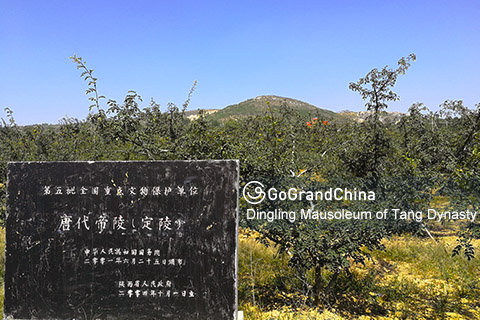
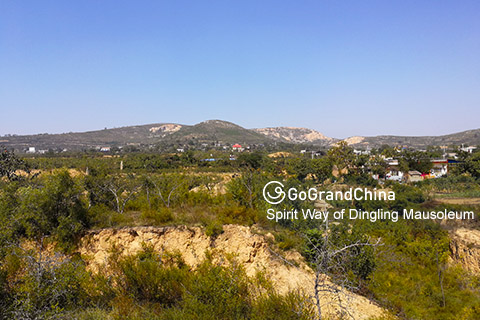
The Spirit Way
Spirit Way is the ornate road leading to a Chinese imperial tomb, starting from the ornamental columns to the Vermilion Gate. It symbolizes the passage of the soul the dead emperor into the world of the spirits. The Spirit Way of Dingling Mausoleum is 624 meters long from south to north and 100 meters wide from east to west. Originally, a pair of Ornamental Columns marked the start of the Spirit Way of Dingling Tomb, followed by a pair of winged horses, a pair of ostriches, five pairs of saddled horses and 10 pairs of government officials. Most of Dingling's stone sculptures were destroyed during the Cultural Revolution. Today, only four statues of government officials can be found standing along the Spirit Way.
Statues of Government Officials
The guardian statues of government officials are called Wengzhong in Chinese. Wengzhong was a giant man of great strength and a general of China's first emperor, Emperor Qin Shihuang. He was garrisoned in Lintao, the west end of Great Wall during the Qin Dynasty and had earned merit in the fight against the Huns. After his death, Emperor Qin Shihuang ordered a bronze statue of Wengzhong to be made after him, placed outside his palace and from then on, bronze or stone statues of humans were called Wengzhong. These stone guardian statues symbolize real government officials guarding the tombs. Originally, 10 pairs of guardian statues were arranged along the spirit way. Today, 4 statues of government officials are standing by the spirit way, one on the east and three on the west. Wearing Tang Dynasty army general's headgear and heavy long robes, they are standing with sword in hands. They play a major role in creating a majestic atmosphere in front of the tomb.
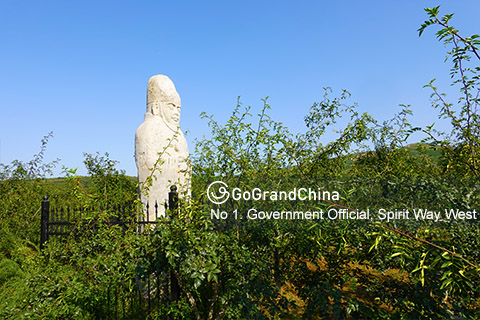
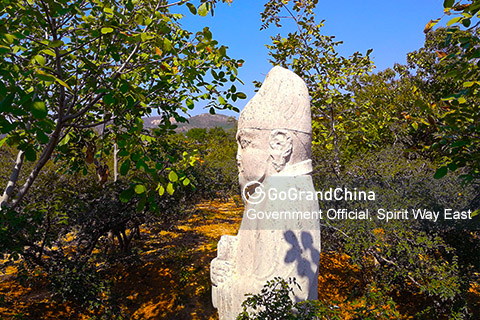
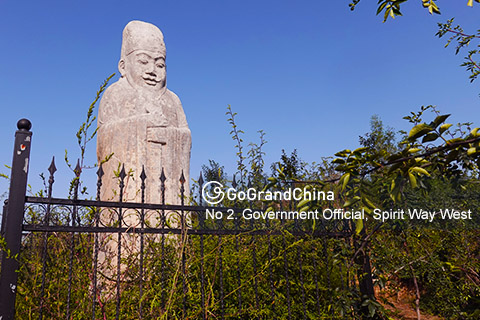
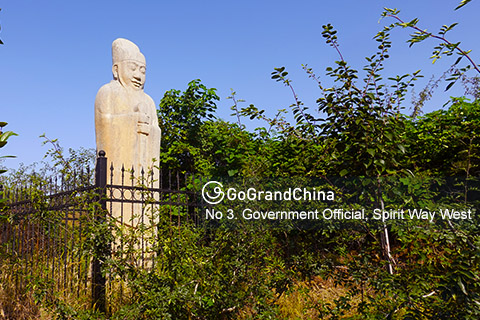
The South Vermilion Bird Gate
The tomb mountain of Dingling was protected by a 12 km long rectangular shaped wall with four gates opened on its four cardinal directions. The south gate is called the Gate of Vermilion Bird. The vermilion bird is one of the Four Symbols of the Chinese constellations representing the direction south. It is described as a red bird that resembles a pheasant with a five-colored plumage and is perpetually covered in flames. Originally, two guarding lions, one male and one female, were placed inside the Vermilion Bird Gate Gate. The east lion was destroyed during the Cultural Revolution. Today, only the west lion is still guarding this gate.
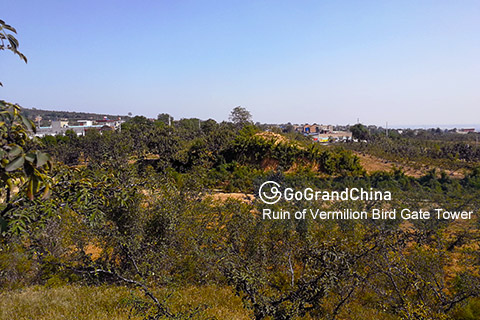
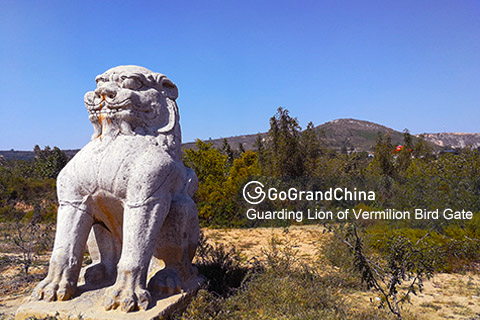
The North Black Tortoise Gate
The black tortoise is one of the Four Symbols of the Chinese constellations representing the direction north. It is usually depicted as a turtle entwined together with a snake. A miniature spirit way is built outside the Black Tortoise Gate in correspondence with the grand spirit way located outside the Vermilion Gate. Originally, two crouching lions were placed inside the gate. A pair of tigers, each with a tamer, and three pairs of saddled horses were lined facing each other outside the black tortoise gate. Today, a headless lion is guarding the north gate, together with a saddled horse.
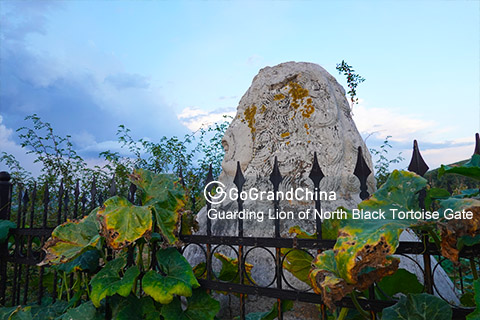
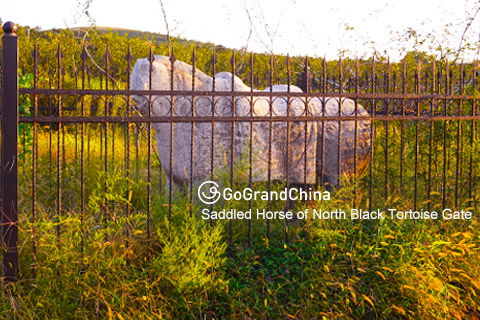
How to get to Dingling Mausoleum of Tang Dynasty
• Dingling Mausoleum is located 75 km (47 mi) away from downtown Xian.
• Rent a car/bus from GGC to enjoy a hassle free private transfer from hotels in Xian to Dingling Mausoleum.
There are no products matching the selection.

